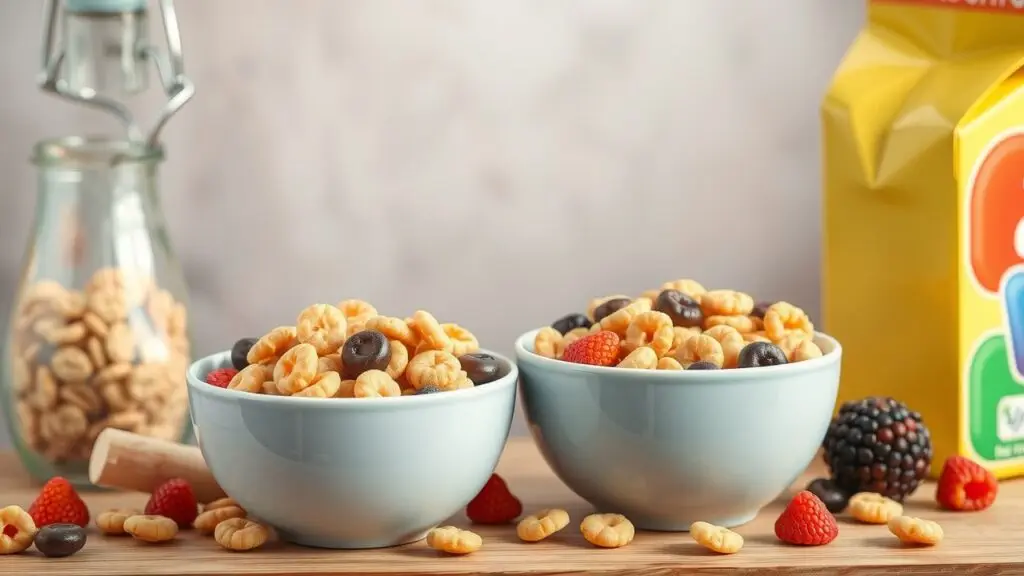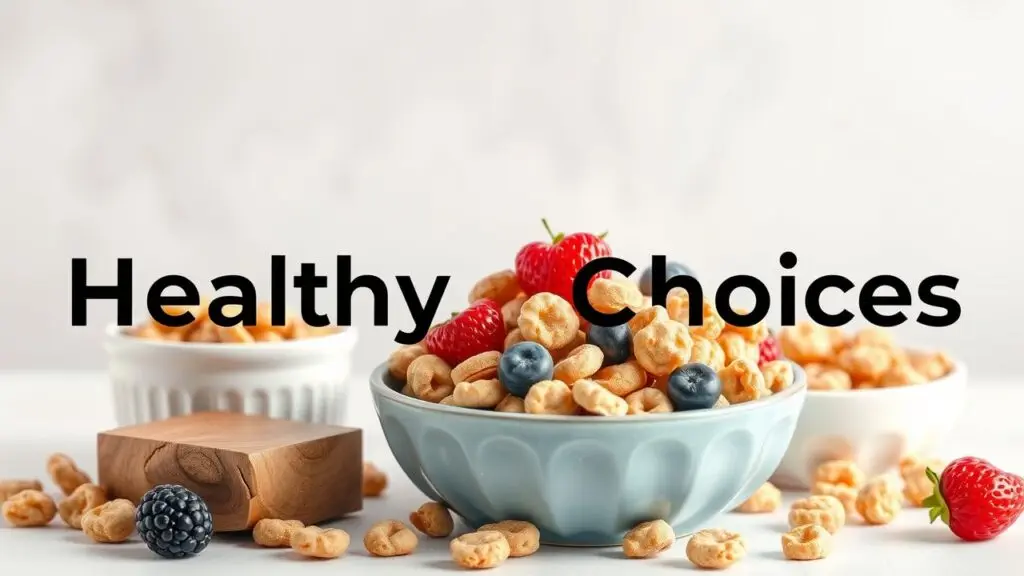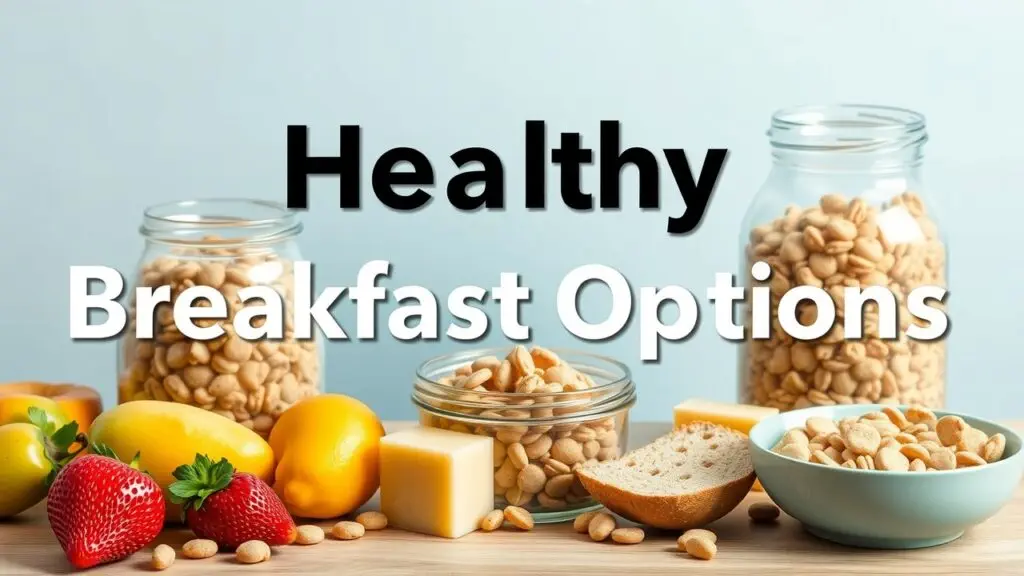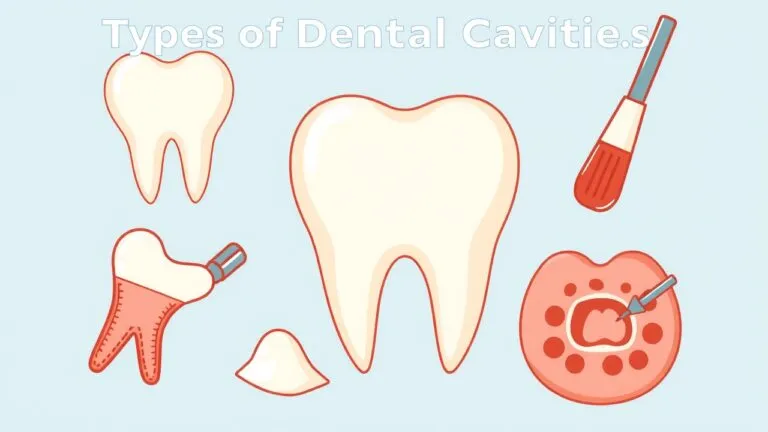This guide explores many types of cereal, from sugary to healthy options, covering choices for kids and adults.
What Are Breakfast Cereals?

Breakfast cereals are processed food made from grains that people eat in the morning. They come in many types, like flakes, puffs, and granola. Breakfast cereals offer a quick way to get energy and nutrients to kickstart your day. Many cereals have added vitamins and minerals, which make them a popular choice for breakfast today.
Cereal has a long history as a breakfast food. It goes back thousands of years when people started grinding grains into flour. But it wasn’t until the late 1800s that ready-to-eat breakfast cereals became common. Companies like Kellogg’s changed how people think about breakfast. Now, cereals are found in kitchens around the world because they are easy to prepare and come in many flavors.
Why Choosing the Right Cereal Matters?
Choosing the right cereal is important for your health and happiness. With so many choices out there—from sugary kinds aimed at kids to healthy options packed with fiber—it’s good to pick one that fits your diet and taste.
Cereals can be divided into two main types: hot and cold. Hot cereals include oatmeal and cream of wheat, which can be comforting during colder days but usually need cooking time. Cold cereals range from cornflakes to granola bars that you can grab quickly.
When picking a cereal, think about these things:
- Healthy Options: Look for whole grains that are high in fiber.
- Low-Sugar Choices: Try to find cereals with less than 5 grams of sugar per serving.
- Kids’ Cereals: Many brands sell sweetened cereals, but you can also find nutritious ones designed for kids that don’t have too much sugar.
By knowing more about different types of cereal, you can make smart choices that help with your health goals while still tasting good!
Types of Ready-to-Eat Cold Cereals Explained
Ready-to-eat cold cereals are a breakfast favorite for many people. They’re easy to prepare and come in lots of varieties. Each type has its own flavors, textures, and nutritional benefits. Knowing about these different kinds can help you choose what works best for your diet and taste.
Flaked Cereals – Popular Choices for Crunchy Mornings
Flaked cereals are some of the most popular breakfast options out there. You might know brands like Corn Flakes and Wheat Flakes. These cereals are often made from whole grains that get processed into thin, crispy flakes. This gives you a crunchy texture that goes great with milk.
When choosing flaked cereals, check the labels. Some are made to be healthier with whole grains and less sugar. Others may have added sugars that cater to kids’ tastes. Finding flaked cereals labeled as “whole grain” can give you better nutrition.
Granola – A Fiber-Rich Option for Health-Conscious Consumers
Granola is well-loved for its health perks. It usually combines oats, nuts, seeds, and sweeteners like honey. This mix creates a fiber-rich cereal that supports good digestion.
You can find many organic granola options or muesli blends too. These mixes often include dried fruits and extra grains, without added sugars or preservatives. Granola isn’t just for breakfast; it also makes a great snack during the day.
Puffed Cereals – Light & Airy Textures
Puffed cereals are all about that light, airy feel. They’re made by puffing rice or corn with heat and pressure. A well-known example is Rice Krispies, which many kids love because they’re crunchy yet easy to chew.
These cereals tend to be lower in calories than denser options but might miss some nutrients found in whole grain cereals. Pairing them with fruits or yogurt can boost their nutritional value at breakfast.
Shredded Wheat – High-Fiber Biscuits
Shredded wheat is another healthy choice for breakfast. These biscuits are made mainly from whole wheat bran, offering high fiber content that’s good for your heart and digestion. Most shredded wheat products don’t have added sugars, making them great for those wanting to cut back on sweetness.
When looking for shredded wheat, aim for brands that use 100% whole grain ingredients. This way, you can enjoy the full benefits of this classic breakfast item while keeping your meal nutritious.
What Is Hot Cereal?

Hot cereal, or cooked cereal, is a warm breakfast choice that people have loved for ages. It usually contains grains like oats or cornmeal. These are boiled in water or milk to make a creamy mix. Well-known types include oatmeal and porridge. Lately, there’s been a surge in interest in these traditional meals due to their health perks and versatility.
Nutritional Benefits of Hot Cereals
Hot cereals are often better than cold cereals because they pack more fiber and protein. This means they can keep you full longer and give you energy throughout the morning. Oatmeal, for example, is loaded with soluble fiber, which helps support heart health by lowering cholesterol. Many hot cereals also have added vitamins and minerals for extra nutrition.
Popular Varieties
You can find many kinds of hot cereals like instant oatmeal and traditional porridge. Instant oatmeal is super easy to make; it takes hardly any time. However, be careful! Some flavored options have lots of added sugars that can affect your health compared to plain ones. Traditional porridge lets you get creative with toppings like fruits or nuts, making it a hearty choice.
Cooking Methods
When it comes to cooking hot cereals, you have options:
- Stovetop Cooking: You boil water or milk first and then add your grains. This takes more time but brings out better flavors.
- Microwaving: This method is faster and great for busy mornings, but it may not taste as rich as stovetop cooking.
Dietary Considerations
Now, many brands offer gluten-free choices in their hot cereal lines, catering to those who need them without losing flavor or nutrition. It’s important to check labels when picking products that fit your dietary needs.
Types of Hot Cereals
- Oatmeal
Oatmeal has different forms like rolled oats and quick-cooking oats. Each type changes how it feels and cooks but keeps similar health benefits due to its high fiber content. - Porridge
Porridge isn’t just made from oats; it can be rice porridge or cornmeal mush too! Each kind carries cultural meaning across various cuisines around the world. - Instant Oatmeal
Instant oatmeal is all about convenience since it’s quick to prepare. But flavored versions might contain more sugar than plain ones. - Steel Cut Oats
Steel cut oats are less processed than other kinds, leading to chewier textures that take longer to cook but are packed with whole grain nutrition. - Other Grain-Based Options
Beyond classic grains like oats, there’s a trend using quinoa or farro in breakfast bowls now—adding diverse nutrients that are good for your diet variety.
Preparing Hot Cereals at Home
Making hot cereal at home can be simple! Here’s how:
- Start with your choice of grain.
- Use water or milk based on how creamy you want it.
- Add some spices like cinnamon or top it with fruits and nuts for extra flavor.
- Watch portion sizes; they help keep breakfast balanced.
Trends in Hot Cereal Consumption
These days, more people want healthy hot breakfasts. Market trends show an increase in ready-to-eat formats for busy lifestyles. Companies are creating new options to meet this demand.
Hot cereals offer great nutrition and variety for anyone looking for a wholesome meal in the morning. They can easily fit into daily diets—so don’t hesitate to explore these delicious options!
Expanding the Cereal Experience
Cereal is a great breakfast food. It comes in many forms, like traditional options such as muesli and granola. There are also convenient snacks, including cereal bars. Knowing about different types of cereal helps people make better choices for their breakfasts and snacks.
Muesli: Ingredients and Preparation Methods
Muesli is a tasty choice for anyone looking for a healthy breakfast cereal. It’s made from rolled oats mixed with nuts, seeds, dried fruits, and sometimes spices. Common ingredients include almonds, walnuts, sunflower seeds, pumpkin seeds, raisins, or cranberries. This mix not only makes it flavorful but also adds to its nutritional value.
There are simple ways to prepare muesli. A popular method is to soak it overnight in milk or yogurt. This softens the oats and makes them easier to digest while blending the flavors nicely. Another way is to enjoy it dry with milk poured on top or with fresh fruit for extra nutrition.
Muesli has many nutritional benefits. It’s high in fiber from the oats, which helps with digestion and keeps you feeling full longer without adding too much sugar. Many brands offer low-sugar options that cater to health-conscious folks who want nutritious foods without losing flavor.
Breakfast Bars: Nutritional Considerations
Breakfast bars are super popular as quick meal solutions, but their nutrition can vary a lot. Some well-known brands use wholesome ingredients like whole grains and nuts. However, others might have additives like high fructose corn syrup or artificial flavors.
When looking at breakfast bars, it’s important to check the sugar content. Some bars can have over 20 grams of sugar per serving! Others are healthier alternatives with 5 grams or less. These are better for everyday eating.
Many products labeled as “healthy” still pack in a lot of added sugars that could mess up your diet plans. So, it’s smart to read labels closely to avoid those hidden sugars and artificial ingredients when picking a breakfast bar.
Comparing Granola to Other Cereal-Based Foods
Granola is another fun category within cereals but it’s quite different from other types like loose granola mixes compared to granola bars. Loose granola usually has clusters made from oats combined with honey or syrup along with nuts and dried fruits; you can enjoy it with milk or yogurt.
On the flip side, granola bars offer easy convenience but may have added sugars that some commercial products use for shelf life instead of health benefits. When deciding between loose granola and granola bars, think about your taste preferences and health goals.
Unique Uses for Cereal Beyond Breakfast
Cereals can be more than just breakfast! Here are some creative ways to use them:
- Toppings: Sprinkle crunchy granolas on yogurt bowls.
- Snack Mixes: Make trail mix by mixing different cereals with nuts & dried fruits.
- Baking: Crush cereals into cookie doughs or muffin batters for extra texture & flavor!
These ideas show how versatile cereal-based foods can be beyond just breakfast time while giving you chances to experiment deliciously in your meals!
Finding the Perfect Cereal for Your Needs

Choosing the right cereal can be tricky. There are many options out there, and it’s important to know what suits your needs. This guide will help you explore different types of cereal, especially the healthy ones. We’ll cover gluten-free, vegan, high-protein, low-sugar cereals, and those for kids.
Gluten-Free Cereals
If you have Celiac disease or gluten sensitivity, it’s vital to pick gluten-free cereals. These cereals don’t have wheat, barley, or rye. Always check the labels when shopping to make sure they are safe.
Vegan Cereals
Vegan cereals avoid all animal products but sometimes include hidden ingredients like honey or dairy. Brands such as Nature’s Path clearly state if their products are vegan on the packaging. Reading ingredient lists is important to spot any animal-based components.
High-Protein Cereals
High-protein cereals help keep your energy up all day long. They also support muscle repair after exercise. Try to find options with at least 10 grams of protein per serving.
Low-Sugar Cereals
Reading nutrition labels is key when looking for low-sugar cereal options. Aim for varieties that have less than 5 grams of sugar per serving for better health over time. Fiber One Original is a great choice because it is high in fiber while keeping sugar low.
Healthy Cereal Choices
Whole grain cereals are usually better choices since they have more fiber than refined grains. Fiber helps digestion and supports heart health by lowering cholesterol levels. Be cautious with added sugars; some options that seem healthy may contain hidden sweeteners under different names on the ingredient lists.
Cereals for Kids
When choosing kids’ cereals, it’s all about finding a balance between nutrition and taste. Kids often want sweeter flavors and fun shapes over plain ones. Look for whole grain-based cereals fortified with vitamins but lower in sugar.
By knowing more about these cereal categories, you can find nutritious options that fit your lifestyle, whether you need something allergen-free or packed with protein.
Making Informed Cereal Choices
Choosing cereal can be tricky with so many options out there. Knowing the different types of breakfast cereals and their nutrition can help you make choices that fit your diet and taste.
Factors to Consider
When picking a cereal, keep these things in mind:
- Dietary Needs: Everyone has different dietary needs. For example, if you’re gluten intolerant, look for gluten-free cereals made from oats or rice.
- Personal Preferences: Taste matters a lot. Some folks like sweet cereals while others prefer whole grain.
- Budget: Cereal prices can vary a lot between brands. Find a good balance between quality and what you can afford.
- Age: Nutritional needs change with age. Kids might need more sugar and calories than adults, who may want more fiber.
Reading Nutrition Labels
Nutrition labels are super important when buying cereal. Focus on these key points:
- Sugar Content: Many cereals have added sugars, which can lead to health problems if you eat too much.
- Fiber Content: Aim for cereals that have at least 3 grams of fiber per serving. This helps with digestion and keeps you feeling full.
- Key Nutrients: Look for vitamins like B12 or minerals such as iron that many breakfast cereals add for extra nutrition.
Balancing Taste and Health
You can find tasty options that are healthy too! Many brands offer cereals aimed at kids that aren’t loaded with sugar or fake flavors. These often use natural sweetness from fruits or honey while keeping sugar levels lower.
Cereals for Different Lifestyles and Ages
There are cereals designed for all kinds of lifestyles:
- Kids’ Cereal: These usually come in fun shapes and colors, often with more sugar but also packed with nutrients they need.
- Adult Cereal: Adults usually go for whole grains, high-fiber choices that keep energy up without too many extra additives.
- High-Fiber Cereal: Great for those looking to aid digestion; these often include bran flakes or oats as main ingredients.
- Gluten-Free Cereal: Made with grains like quinoa or cornmeal for those avoiding gluten due to celiac disease or sensitivity.
By thinking about these factors when choosing your next box of cereal, you can pick options that work for your health goals and personal tastes!
FAQs About Cereal Types
What are the different types of cereal?
Cereals fall into several categories, including flaked cereals, puffed cereals, granola, shredded wheat, and hot cereals like oatmeal and porridge.
Which cereals are best for kids?
Kids often enjoy sweetened cereals. Look for options that combine taste with nutrition.
What should I consider when buying cereal?
Check for whole grains, sugar content, and added vitamins. Choose cereals high in fiber and low in sugar for better health.
Are there gluten-free options available?
Yes, many brands offer gluten-free cereals made from rice, corn, or oats. Always read labels to ensure safety.
How can I make my cereal healthier?
Add fresh fruit, nuts, or seeds to boost nutrition. Swap out regular milk for yogurt or a milk alternative for added benefits.
Additional Unique Points on Cereal Varieties
- Cereal Ingredients: Cereals commonly contain grains like oats, wheat, or corn. Some include dried fruits or nuts.
- Nutritional Content: Many breakfast cereals fortify their products with vitamins such as B12 and minerals like iron.
- Types of Cereal Grains: Common grains include wheat flakes, rice cereal, barley cereal, and oat cereal.
- Cereal Marketing Trends: Cereal brands use creative packaging and mascots to attract consumers of all ages.
- Cereal for Weight Loss: Low-sugar and high-fiber options can aid in weight management while providing essential nutrients.
- Seasonal Cereals: Limited edition flavors appear during holidays like Christmas and Halloween to keep things exciting.
- Cereal Pairings: Combine cereals with yogurt or milk alternatives to enhance flavor while maintaining a nutritious balance.
Related Topics
- types of breakfast cereals
- types of hot cereals
- types of ready-to-eat cold cereals
- types of cereal grains
- types of cereal brands
- types of cereal for kids
- types of gluten-free cereals
- types of vegan cereals
- types of high-protein cereals
- types of low-sugar cereals
- types of oatmeal
- types of porridge



Types of Cereal: A Complete Guide to Breakfast Cereal Types